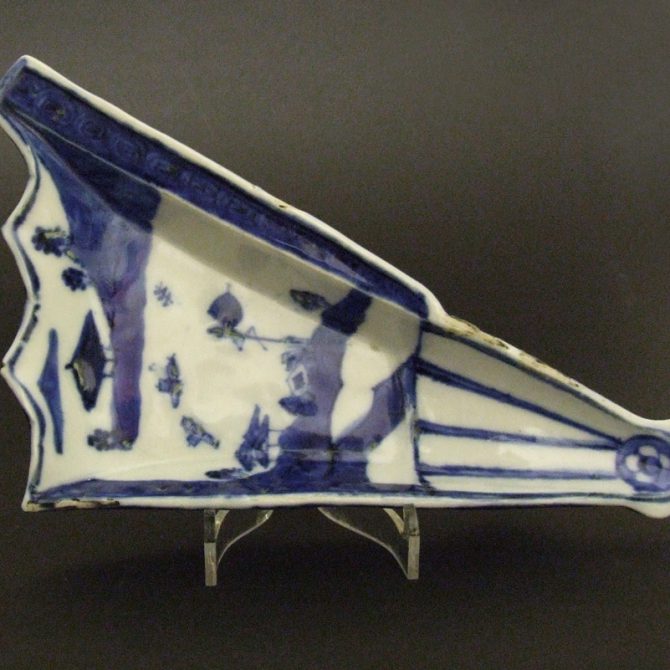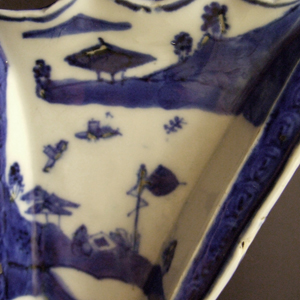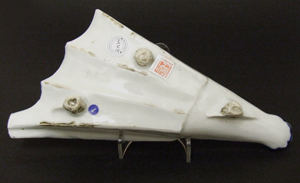
TIANQI 1621 – 1627 Ming Porcelain for the Japanese Market
A Rare Transitional Blue and White Porcelain Ko-Sometsuke Mukozuke Dish, Ming Dynasty, Tianqi Period 1621-1627. Modelled in the Form of a Partially Unfolded Fan and Decorated with Figures in a River Landscape with Two in the Foreground Playing Go . The Naturalistically Modelled Back is Unpainted and has Three Thickly Potted Circular Feet.
SOLD
- Condition
- A chip to the leading edge of the fan half way down c.20 mm, partly just in the glaze. Small chips and Mushikui rim fritting, some unevenness in the glazing.
- Size
- Length : 24 cm (9 1/2 inches)
- Provenance
- Ove Stenbeck Collection.
- Stock number
- 21972
- References
- For a set of five similar Ming porcelain fan shaped dishes for the Japanese market see : The Peony Pavilion Collection, Chinese Tea Ceramics for Japan (c.1580-1650). Christie`s, London, 12th June 1989, lot 255. The author states "The fan shape suggests a pleasant breeze, and hence these types of Mukozuke would have been excellent for early-morning kaiseki. In this dawn kaiseki, grilled fish was slightly too heavy and strongly flavoured, as the major constituent, something vegetable would have been preferred.
Information
Ko-Sometsuke :
Ko-Sometsuke, meaning `Old Blue and White` is a term used to describe Chinese blue and white porcelain made for Japan. This late Ming porcelain was made from the Wanli period (1573-1620) and ended in the Chongzhen period (1628-1644), the main period of production being the 1620`2 and 1630`s. The porcelain objects produced were made especially for the Japanese market, both the shapes and the designs were tailored to Japanese taste, the production process too allowed for Japanese aesthetics to be included in the finished object. Its seams firing faults were added, repaired tears in the leather-hard body were too frequent to not, in some cases, be deliberate. These imperfections as well as the fritting Mushikui (insect-nibbled) rims and kiln grit on the footrims all added to the Japanese aesthetic. The shapes created were often expressly made for the Japanese tea ceremony meal, the Kaiseki, small dishes for serving food at the tea ceremony are the most commonly encountered form. Designs, presumably taken from Japanese drawings sent to China, are very varied, often using large amount of the white porcelain contrasting well with the asymmetry of the design.
Weiqi :
Go known in Chinese as Weiqi and Go in Japan, is an ancient board game for two players that is noted for being rich in strategy despite its simple rules. The game is played by two players who alternately place black and white stones on the vacant intersections of a grid of 19×19 lines. The object of the game is to control (surround) a larger portion of the board than the opponent. Weiqi originated in ancient China more than 2,500 years ago, and although it is not known exactly when the game was invented, by the 3rd century BC it was already a popular pastime, as indicated by a reference to the game in the Analects of Confucius. Go reached the West through Japan, which is why it is commonly known by its Japanese name. From http://en.wikipedia.org/wiki/Go_%28game%29

